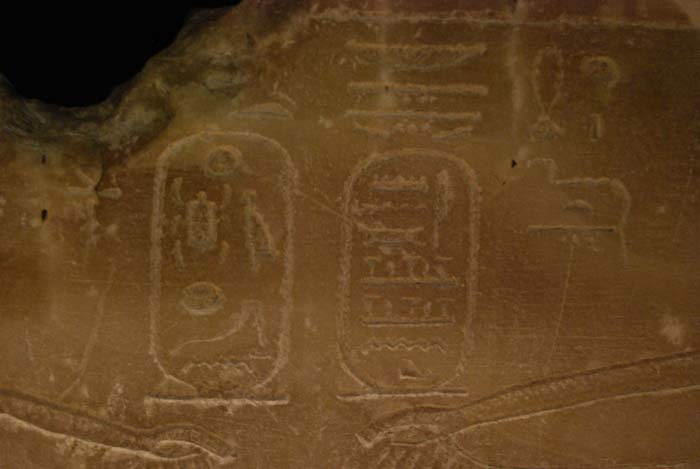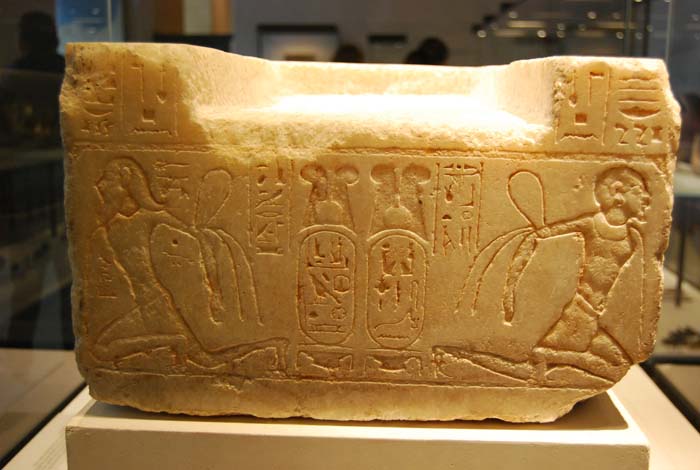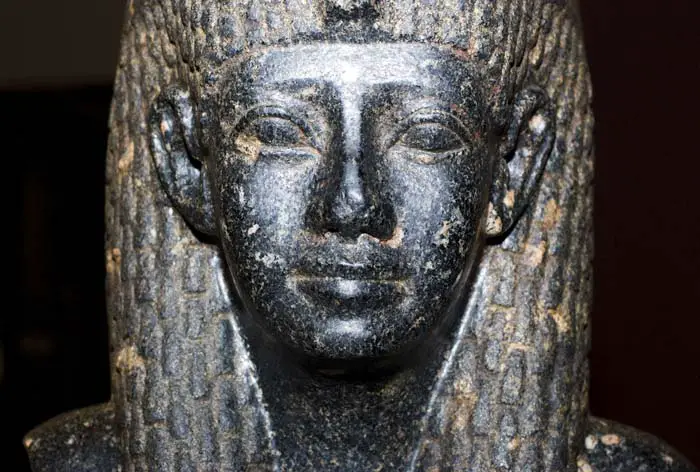Third Intermediate Period (1069-664 B.C.)
This period differed from the other intermediate periods because it was a time of relative stability. Egyptian culture flourished but several dynasties ruled in different areas. The idea of a unified Egypt began to erode and economic problems plagued the pharaohs.
21st Dynasty
The 21st Dynasty ruled the north and some pharaohs might have been Libyan. The high priest of Amun-Ra ruled Thebes and taught that the pharaoh was a temporary appointee of Amun-Ra. The activities of this dynasty are not well documented but they did build at Tanis and Memphis. A princess of this dynasty married King Solomon of Israel which would have been impossible in earlier periods.
22nd Dynasty
This was another northern dynasty of which, Sheshonq I was the most important pharaoh. He re-established political authority and expanded into foreign territories. Sheshonq I named his son the high priest of Amun-Ra and campaigned into the Levant. His successors were unable to continue his attempts of reunification because of the power of local rulers.
 © Heidi Kontkanen – Cartouche of Sheshonq I
© Heidi Kontkanen – Cartouche of Sheshonq I
23rd Dynasty
Kings based in various capitals who were contemporary with the late 22nd, the 24th and the early 25th Dynasties.
24th Dynasty
This dynasty’s capital was in Sais and was a leader throughout the Delta as far south as Herakleopolis.
25th Dynasty
The 25th Dynasty’s main palace was in Memphis and some individuals might have been Nubian. The Nubians respected the religion and culture of the Egyptians. This dynasty established the post of “god’s wife of Amun” held by celibate royal women. These women would adopt an heir from the royal family and eclipsed the power of the high priest. This dynasty had to defend against the advancement of Assyria.
Many government posts during this dynasty were hereditary. Military might served as the basis for this dynasty’s power. It also saw a rise in deity Triads, consisting of a god, a goddess and their child. They re-used older monuments and people stripped older royal mummies of their grave goods. This dynasty’s capital was at Memphis.
Late Period (664-332 B.C.)
26th Dynasty
Psamtek I reunited Egypt with Assyrian support. His centers of power were at Sais, Memphis and Athribis. Psamtek I ended his connection with Assyria and established trade routes with Greece and Phoenicia. He gained power through diplomatic means and made his daughter heir to the “god’s wife of Amun”.
All the kings either built or re-built temples. Their final resting places were in chapel tombs in the cult temple of Neith at Sais. These pharaohs also standardized to order of the Book of the Dead. These rulers moved troops into Asia as far as the Euphrates and favored the Blue War Crown in their depictions. They allied with the Greeks against Persia.
27th Dynasty
This dynasty marks the first Persian Period and began when King Cambyses invaded Egypt. He captured Psamtek III, the last 26th Dynasty pharaoh, and set himself on Egypt’s throne. It is important to remember that the Persian pharaohs lived in modern Iran and some never set foot in Egypt. Classical authors, most of whom were Greek, depict Cambyses in a negative light.
Egyptian evidence shows he was anxious not to offend the Egyptians. Cambyses made an effort to present himself as a pharaoh in several ways. He assumed all the traditional forms of Egyptian kingship. Cambyses was willing to work with the Egyptians and promote them. He also showed great respect for the Egyptian religion.
Over time, resentment grew and problems erupted between the Egyptians and the Persians. The priests of Khnum and Jewish mercenaries at Elephantine fought. It culminated with the destruction of a temple dedicated to Yahweh by the Egyptians. Around this time, Egypt rebelled against Persian rule.
28th Dynasty
This dynasty only had one pharaoh, Amyrtaios, who succeeded in rebelling against Persian rule.
29th Dynasty
These kings had short reigns and many were deposed or murdered.
30th Dynasty
This dynasty came to power after its founder, Nectanebo I, staged a successful military coup. The final native Egyptian pharaoh was Nectanebo II. This dynasty, and the rule of the native Egyptians, ended with the invasion of Persia.
 © Heidi Kontkanen – Cartouche of Nectanebo II
© Heidi Kontkanen – Cartouche of Nectanebo II
Second Persian Period
This period began in 341 B.C. and operated in a different way from the First Persian Period. The kings plundered the temples and destroyed the defensive systems of the major cities. Egypt’s cultural life continued during the Late Period without stopping. The native Egyptians rebelled against the Persian rule and they welcomed the Greek’s arrival.
Ptolemaic Period (332-30 B.C.)
This period began with Alexander the Great of Macedon’s invasion of Egypt. He founded the city of Alexandria and established the Greek government of Egypt. After Alexander’s death, his heirs were unable to keep his kingdom intact. It divided into a three kingdoms; Macedon, the Seleucid Empire, and the Ptolemaic Empire.
The first war of succession took place between two groups of nobles. One group wanted to keep Alexander’s kingdom intact and the other wanted it divided. Ptolemy belonged to the second group and held off two invasions during the first war of succession. He declared himself king of Egypt before the second war began.
Ptolemaic Dynasty
The Ptolemies saw themselves as Greek and they wanted to expand into two regions. They sought to gain prestige by controlling Greek culture centers in Asia Minor and the Levant. There were conflicts with the Selucids and Macedon and they drove the Ptolemies out of Greece and Asia Minor.
This dynasty sought to control the trade routes in Syria to enlarge their economy. At first, the Ptolemies administration was stable and the economy allowed for expansion. After a time, the economy weakened and the Ptolemies could not maintain their army.
Cultural life during the Ptolemaic Period was vibrant and varied. The Ptolemies built the Mouseionto be a center of instruction and research. The Great Library was part of the Mouseion and people traveled all over the Greek world to get texts. By the end of this period, the library had at least 700,000 volumes. Jews translated the Septuagint in the Mouseion.
The Ptolemies had some unique characteristics. First, they regarded the Greek god Zeus as the father of their dynasty. Second, it became normal for full royal siblings to marry. While royal siblings married in early periods, these couples were half-siblings. Internal strive within the family caused problems within the royal family.
Cleopatra VII was the last pharaoh of Egypt who faced Rome’s advance into Egypt. She also fought with her brother/husbands Ptolemy XIII and XIV. Cleopatra’s lover, Mark Antony, helped her exert control in Asia Minor and Syrian. Augustus invaded Egypt in 30 B.C. and killed Mark Antony. Records say that Cleopatra VII committed suicide.
 © PJMixer – Statue of Cleopatra VII
© PJMixer – Statue of Cleopatra VII
Roman Period
Roman Egypt had more in common with the culture of pharaonic Egypt than that of Rome. They used hieroglyphics and built temples in Egyptian styles. Mummification was important and Roman coffins had paintings showing distinctive Roman styles and characteristics. The Romans revered Egyptian gods. Scholars discovered papyri and ostracon (pottery shards with writing) recording daily Roman life.
Egypt’s economy had three aspects; agriculture, mines and quarries, and trade. The city of Rome relied on Alexandrian grain ships for food. Rome mined in the Eastern Desert for different types of stone. Egyptian red granite was one of the three most popular types of decorative stones. One type of rock discovered was purple and the emperors considered it valuable. Egypt facilitated Roman trade with India and other areas of the Orient.
Rome associated the Egyptian gods with Greek and Roman gods. During the first century A.D., Christianity started in Alexandria and spread throughout Egypt. After the division of the Roman Empire, Egypt came under the control of the Byzantine Empire. By this time, the emperor had outlawed the worship of the Egyptian gods and Christianity was the Empire’s religion. Roman rule ended when the Arab-Muslim armies conquered Egypt in 642 A.D.















































